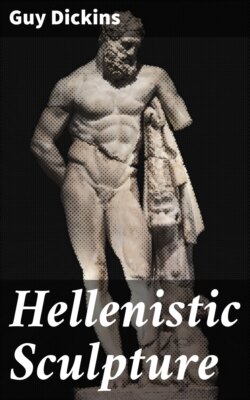Hellenistic Sculpture

Реклама. ООО «ЛитРес», ИНН: 7719571260.
Оглавление
Guy Dickins. Hellenistic Sculpture
Hellenistic Sculpture
Table of Contents
PREFACE
ILLUSTRATIONS
I. THE SCHOOL OF PERGAMON
II. THE SCHOOL OF ALEXANDRIA
III. THE RHODIAN SCHOOL
IV. THE MAINLAND SCHOOLS DURING THE HELLENISTIC AGE
V. GRECO-ROMAN SCULPTURE
APPENDIX. PUBLISHED WORKS OF THE AUTHOR
Footnote
INDEX
Отрывок из книги
Guy Dickins
Published by Good Press, 2021
.....
These works all deserve careful study, as they differ in many ways from the rather sensual and ecstatic art which we know to have preceded them, and the very baroque and exaggerated art which followed them in the next century on the great altar. Eumenes and Attalos had to fight for their lives against the Gauls, and a temporary return to an austerer and less luxurious art would be a not unnatural result of the great war. We certainly find in the treatment of the Amazons or of the wife of the Ludovisi Gaul no such insistence on sexual detail as marks the earlier studies of the feminine form, and the expression of the male figures is distinguished by more ideal emotions of courage or resignation than the frenzy of the satyrs and the passions of the later gods and giants. The Attalid dedications show some bravura of pose; the Ludovisi Gaul is a little histrionic in his attitude; but as a whole they are sober and restrained sculpture, when compared with the satyrs on the one hand and the altar frieze on the other. In that sense they represent the high-water mark of Pergamene art, inspired with an equal skill, but with a nobler ideal than the earlier work, and not subject to the somewhat grotesque exaggerations of its later activities. Greek art has few nobler figures to show than the Dying Gaul of the Capitol, itself an admirable and closely contemporary copy, perhaps made in Ephesos, of the bronze original at Pergamon. The sober restraint of the torso modelling is remarkable, and contrasts most forcibly with the altar frieze. The pathos of the expression and attitude is not forced or exaggerated in any way, and if the curious hair gives a touch of strangeness to the head, we must account for it as a naturalistic detail of the Gallic fashion of greasing and oiling the hair. The Ludovisi Gaul is a superb work, rather more exaggerated, both in expression and in detail, than the Capitol figure. The right arm is perhaps wrongly restored, as it hides the face from the front, but it is more likely that the group should be looked at from a position farther to the left, where the face, the fine stride, and the technical tour de force of the cloak can all be appreciated more fully. The woman’s face is not well finished, and her whole pose is more effective from the other point of view. The Pergamene peculiarities in the treatment of chest and waist are clearly visible in this figure.
The little figures in Naples, the Louvre, Venice, and elsewhere are partly recumbent dead figures of Persians, giants, and Amazons, and partly crouching figures defending themselves. None of the victorious Greeks seems to have survived, except possibly the torso of a horseman in the Terme Museum. They are dry, rather hard figures, much inferior in skill to the larger group and much closer to the bronze originals which they represent. The head of a dead Persian in the Terme Museum (Fig.5) is probably a more worthy copy (on a larger scale) of one of the figures of this series. Its type of features and its moustache resemble the Ludovisi Gaul. Another fine Gallic head is in the Gizeh Museum at Cairo (Fig.6). This has been often called an original, an Alexandrian variant of the Gallic dedications. There is, however, no need to separate it from the others. If it shows more emotion, that only brings it rather closer to what we know of earlier Pergamene art. The provenance of the Gizeh head is disputed, and it may be only a recent importation into Egypt.24
.....